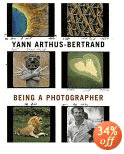Yann Arthus-Bertrand: Being a Photographer

by Harry N.
240 pages,
ISBN: 0810956160
Post Your Opinion | | Perspectives by Arthus-Bertrand
by Christopher Ondaatje
Being a Photographer is a book about the extraordinarily versatile French photographer
Yann Arthus-Bertrand. The text of the book by Sophie Troubac has been translated from
the French by Simon Moore. It is an interesting character study of a determined
photographer who broke several barriers with his masterpiece, Earth from Above,
published in 1999. That book's first printing of 120,000 copies sold out in a mere two
weeks. Today more than two and a half million copies have been sold in a variety of
languages and over a hundred of these amazing aerial images have been exhibited on the
garden railings outside the Luxembourg Museum in Paris, where they attracted some two
million visitors. The exhibition has now been installed in fifty of the world's biggest
cities, and it is estimated that at least sixty million people have viewed the images.
Photographs in relief have even been included for the blind and partially sighted.
This smaller book does not attempt to duplicate the artistic creation of Earth from Above.
However, it does reveal a great deal about the photographer as a person and it includes
many of the best aerial images, as well as some of the photographer's earlier African
work and his unusually personal portraits. In addition, Being a Photographer includes a
remarkable DVD disc directed by Emilio Pacull who had, in his time, been an assistant to
directors Costa-Gavras, Roberto Rosellini and Frantois Truffant. Pacull came across
Arthus-Bertrand's portraits when he first saw his outdoor exhibition at the Paris
Luxembourg Gardens in 2000. This short, simple and complex film is as faithful to
Arthus-Bertrand as his photographs are to the earth.
Arthus-Bertrand's adventurous photographic career began in Kenya in 1979 where he
followed a pride of lions over a three-year period. He first became fascinated with aerial
photography while organising balloon trips for tourists, and eventually that's how he
made his name. However, in the twenty years before Earth from Above was published,
Arthus-Bertrand started working for travel publications, photographing the Paris-Dakar
Rally, tennis players at Roland-Garros, Paris Agricultural Shows, and later did a project
on the French for l'Express. His remarkable portraits include breeders with their animals,
President Mitterand, prostitutes, plumbers, policemen and bakers, "because it consigns
everyone to the same level, and brings out the distinctions in each individual." As a
photographer, Arthus-Bertrand does not harbour illusions. Rather he is shaped by them.
Purists argue that this is a major flaw, but the reality is that Arthus-Bertrand has
somehow managed to extract something unique out of his subjects. It is almost as if he
has gouged his fingers into their flesh and then smeared their soul on his canvas. There is
something eerily revealing about these earlier studies which are quite different from the
dazzling geometrical scenes in Earth from Above. In 1992 a pilot flying over New
Caledonia pointed out a clearing in the shape of a heart formed by the Voh Mangrove. It
quickly became the emblem of the photographer's projectů"to raise public awareness of
the Earth's beauty in order to better condemn its problems." Not everyone likes Arthus-
Bertrand's photographs, or even accepts their message, yet "the enthusiasm and emotion
they ceaselessly inspire remain unquestioned. There is an intensity and a mystery about
them. Such expression testifies to the fact that humanity, in its many different guises,
shares a common adventure."
During the 1980s photography went through a revolution. All the leading agencies
experienced a crisis from which they may never fully recover. Cartier-Bresson left
Magnum, Depardon broke with Gama Riboud, Salgado, Brassai, Doisneau, Boubat, as
well as the late Gilles Canon, left the militantly organised photographic world. Colour
had begun to establish itself over black-and-white images. Adventure and travel
magazines were created and photographers, spurred on by writers and publishers,
reported on major world developments. This period introduced the photography of
escapism, and penetrated even the most reclusive countries. Arthus-Bertrand explains: "It
provided us with an existence. All the photographers of my generation owe these
publications a great deal. They gave our work a platform and strengthened our images."
He is right. This book by Sophie Troubac, along with Yann Arthus-Bertrand's own
commentaries, photographs, notebooks, and the biographical DVD documentary, tells us
something about how a tirelessly determined and passionate photographer took advantage
of the changing world of photography and photojournalism. It does not recommend a
particular path that any young ambitious photographer should take, but it provide an eye-
opening lesson on how good packaging and creative merchandising can market and
establish a gifted and hard-working photographer.
Christopher Ondaatje is a retired investment banker, an author and a trustee of the
National Portrait Gallery.
|